CHEVROLET CORVETTE 1996 4.G Owners Manual
Manufacturer: CHEVROLET, Model Year: 1996, Model line: CORVETTE, Model: CHEVROLET CORVETTE 1996 4.GPages: 386, PDF Size: 20.12 MB
Page 271 of 386
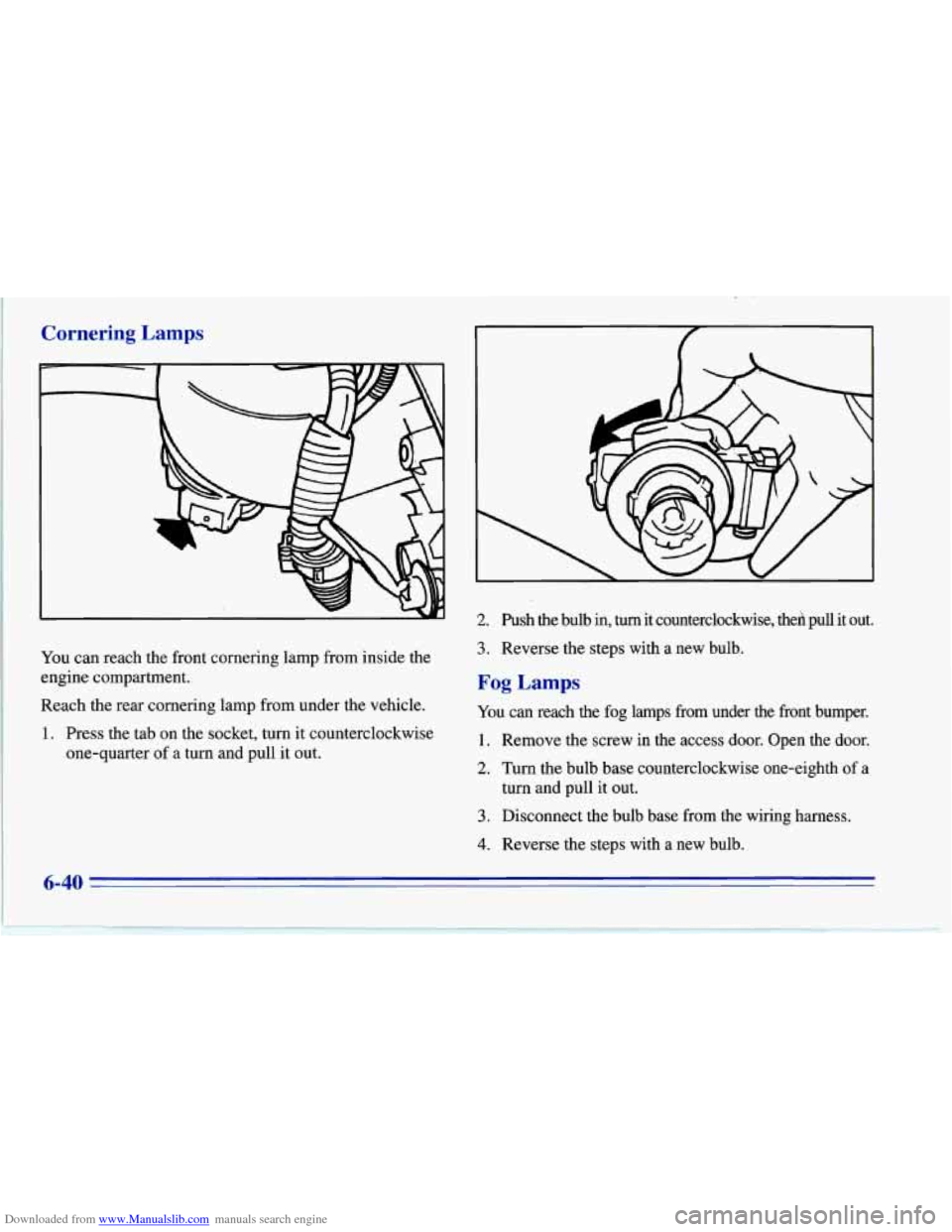
Downloaded from www.Manualslib.com manuals search engine Cornering Lamps
You can reach the front cornering lamp from inside the
engine compartment.
Reach the rear cornering lamp from under the vehicle.
1. Press the tab on the socket, turn it counterclockwise
one-quarter
of a turn and pull it out.
6-40
1_
2. Push the bulb in, turn it counterclockwise, theh pull it out.
3. Reverse the steps with a new bulb.
Fog Lamps
You can reach the fog lamps from under the front bumper.
1. Remove the screw in the access door. Open the door.
2. Turn the bulb base counterclockwise one-eighth of a
3. Disconnect the bulb base from the wiring harness.
4. Reverse the steps with a new bulb.
turn and pull
it out.
Page 272 of 386
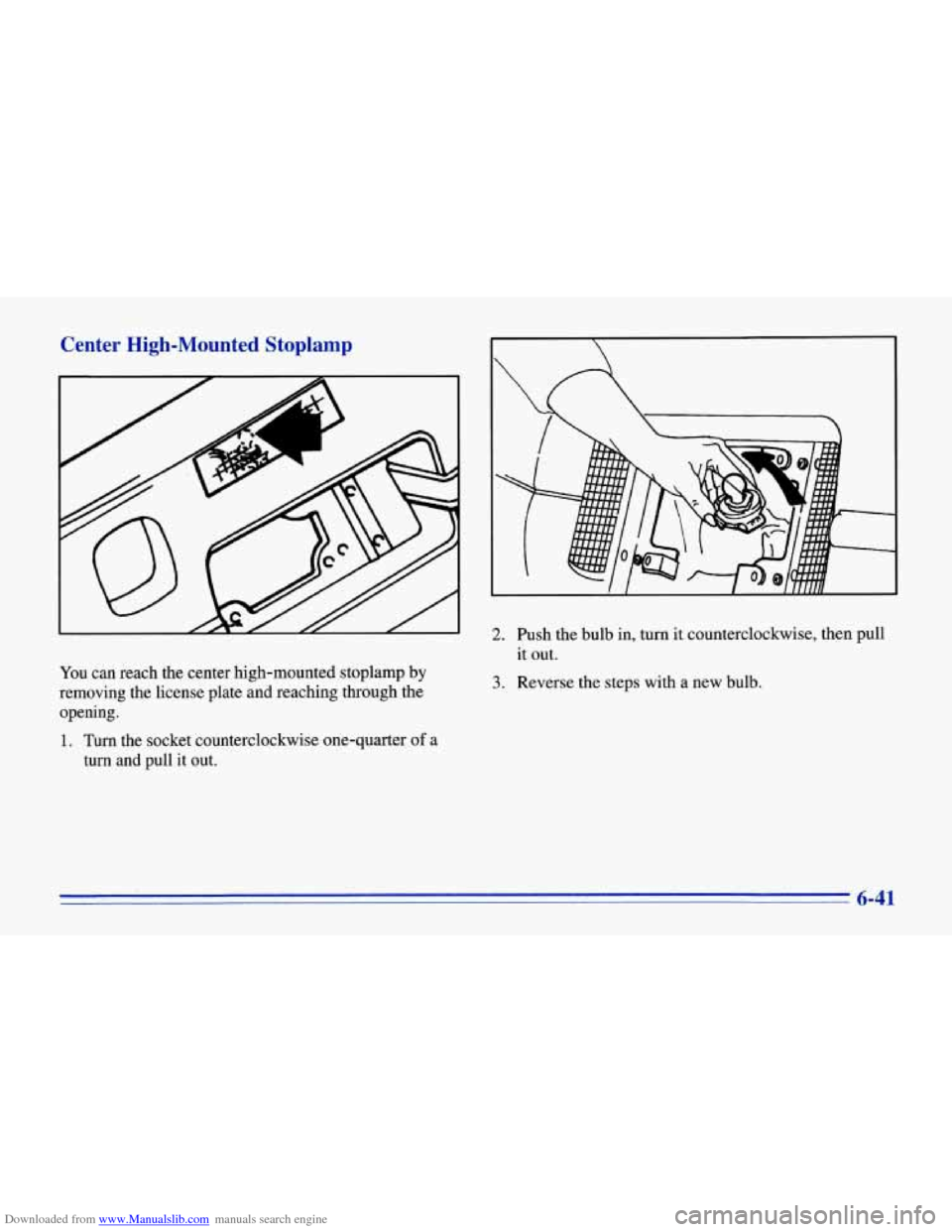
Downloaded from www.Manualslib.com manuals search engine Center High-Mounted Stoplamp
You can reach the center high-mounted stoplamp by
removing the license plate and reaching through the
opening.
1. Turn the socket counterclockwise one-quarter of a
turn and pull it out.
2. Push the bulb in, turn it counterclockwise, then pull
it out.
3. Reverse the steps with a new bulb.
6-41
Page 273 of 386
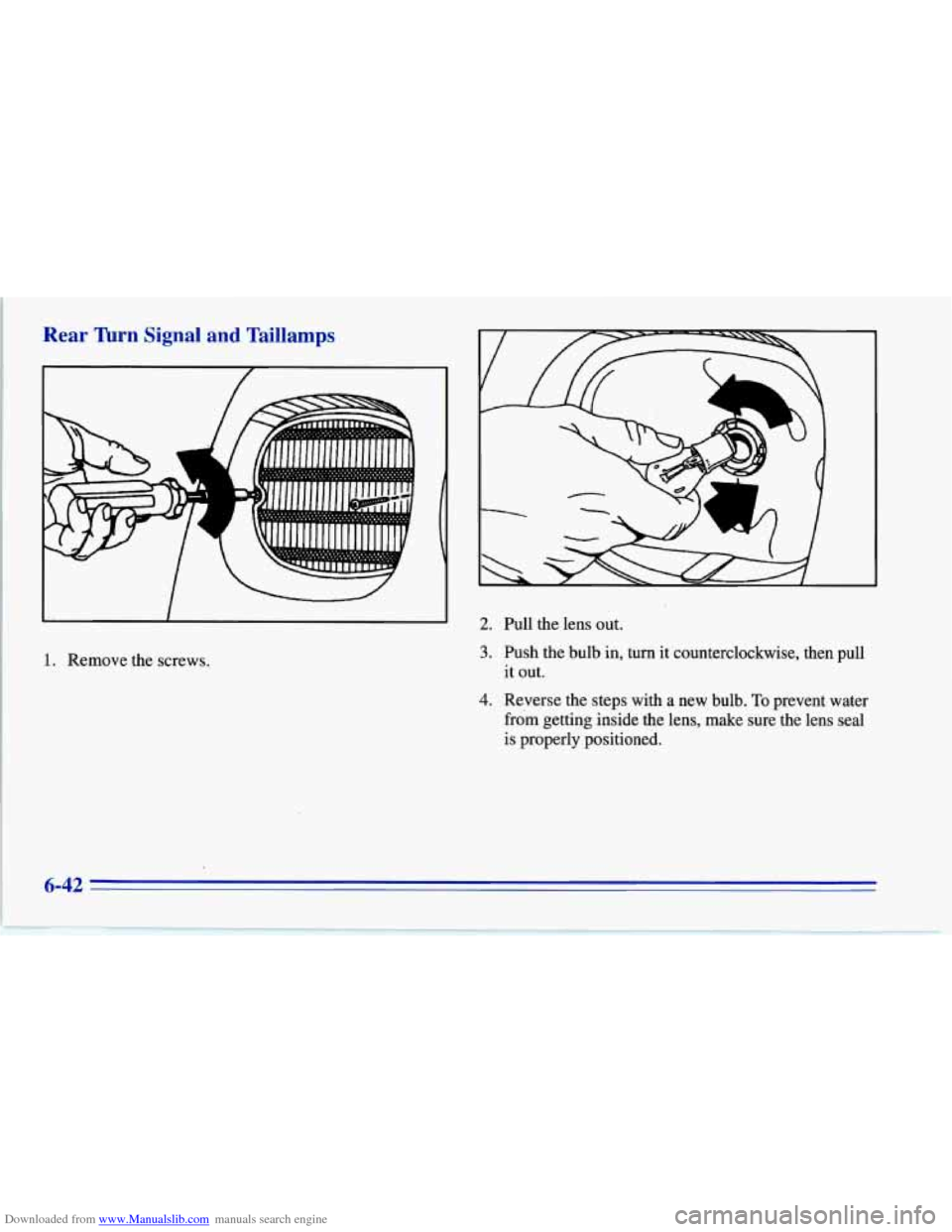
Downloaded from www.Manualslib.com manuals search engine Rear Turn Signal and Taillamps
I
I
1. Remove the screws.
2. Pull the lens out.
3. Push the bulb in, turn it counterclockwise, then pull
it out.
4. Reverse the steps with a new bulb. To prevent water
from getting inside the lens, make sure the lens seal
is properly positioned.
6-42
Page 274 of 386
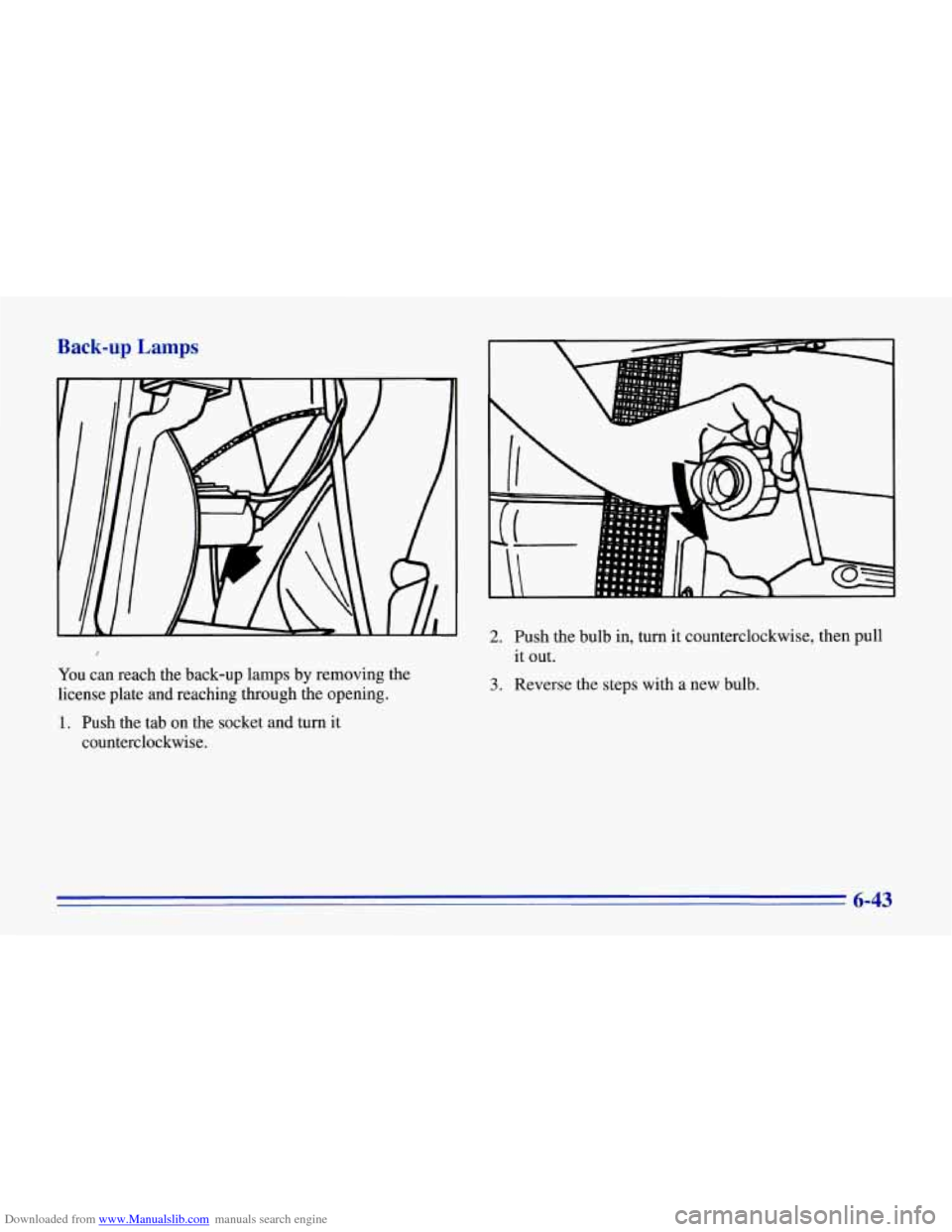
Downloaded from www.Manualslib.com manuals search engine Back-up Lamps
I
You can reach the back-up lamps by removing the
license plate and reaching through the opening.
1. Push the tab on the socket and turn it
counterclockwise.
2. Push the bulb in, turn it counterclockwise, then pull
it out.
3. Reverse the steps with a new bulb.
6-43
Page 275 of 386
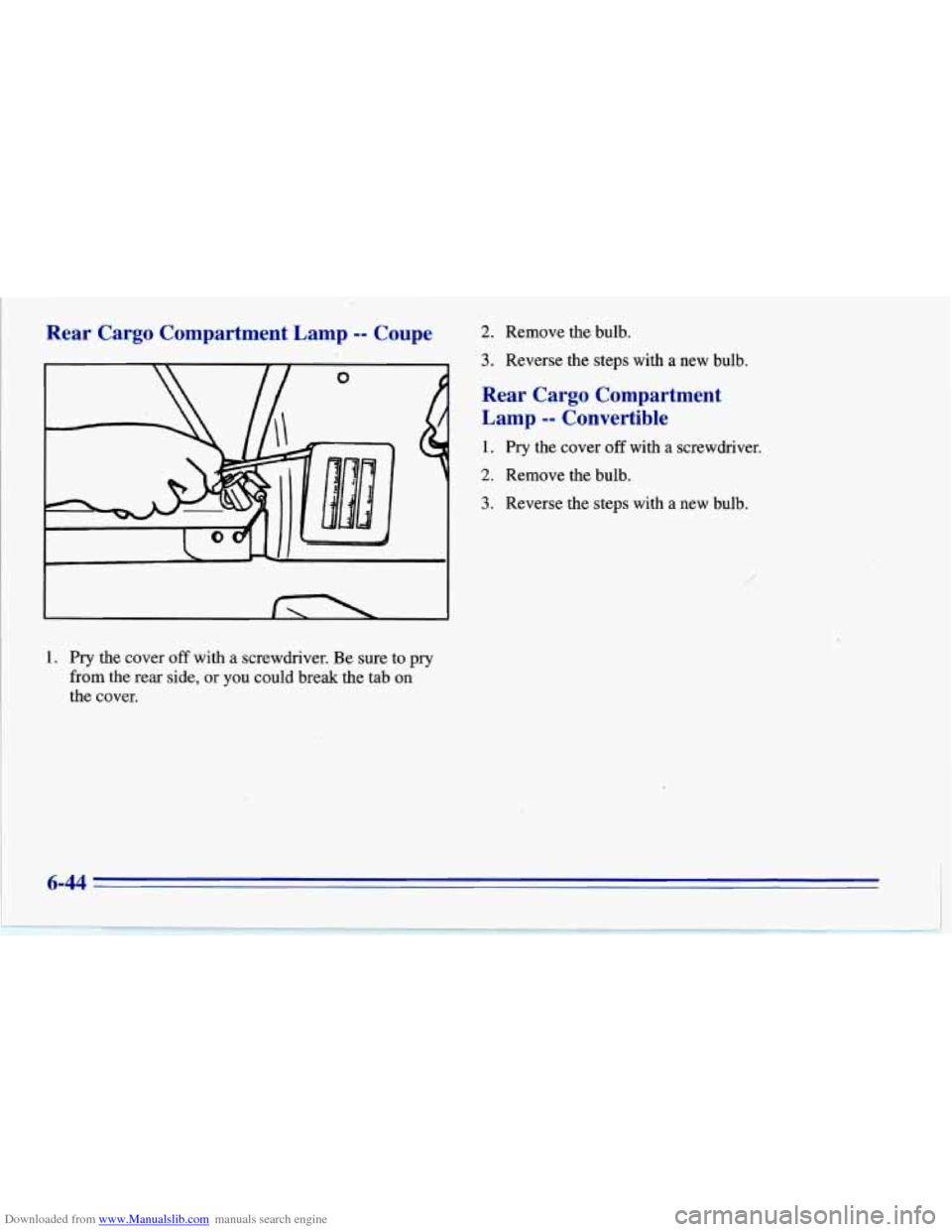
Downloaded from www.Manualslib.com manuals search engine Rear Cargo Compartment Lamp -- Coupe
1. Pry the cover off with a screwdriver. Be sure to pry
from the rear side,
or you could break the tab on
the cover.
6-44
2. Remove the bulb.
3. Reverse the steps with a new bulb.
Rear Cargo Compartment
Lamp
-- Convertible
1. Pry the cover off with a screwdriver.
2. Remove the bulb.
3. Reverse the steps with a new bulb.
Page 276 of 386
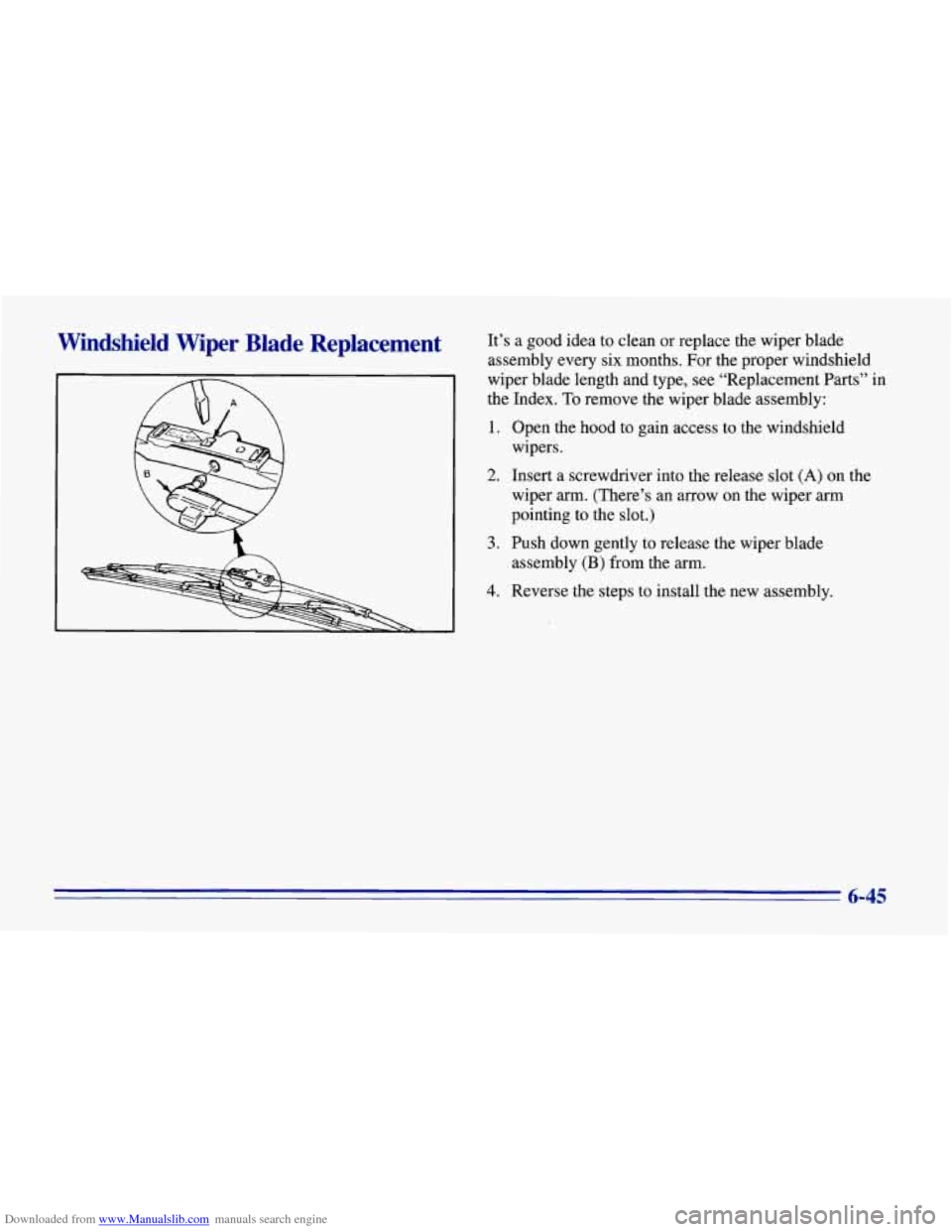
Downloaded from www.Manualslib.com manuals search engine Windshield Wiper Blade Replacement It’s a good idea to clean or replace the wiper blade
assembly every six months. For the proper windshield
wiper blade length and type, see “Replacement Parts” in
the Index.
To remove the wiper blade assembly:
1.
2.
3.
4.
Open the hood to gain access to the windshield
wipers.
Insert a screwdriver into the release slot
(A) on the
wiper arm. (There’s an arrow on the wiper arm
pointing to the slot.)
Push down gently to release the wiper blade
assembly
(B) from the arm.
Reverse the steps to install the new assembly.
6-45
Page 277 of 386
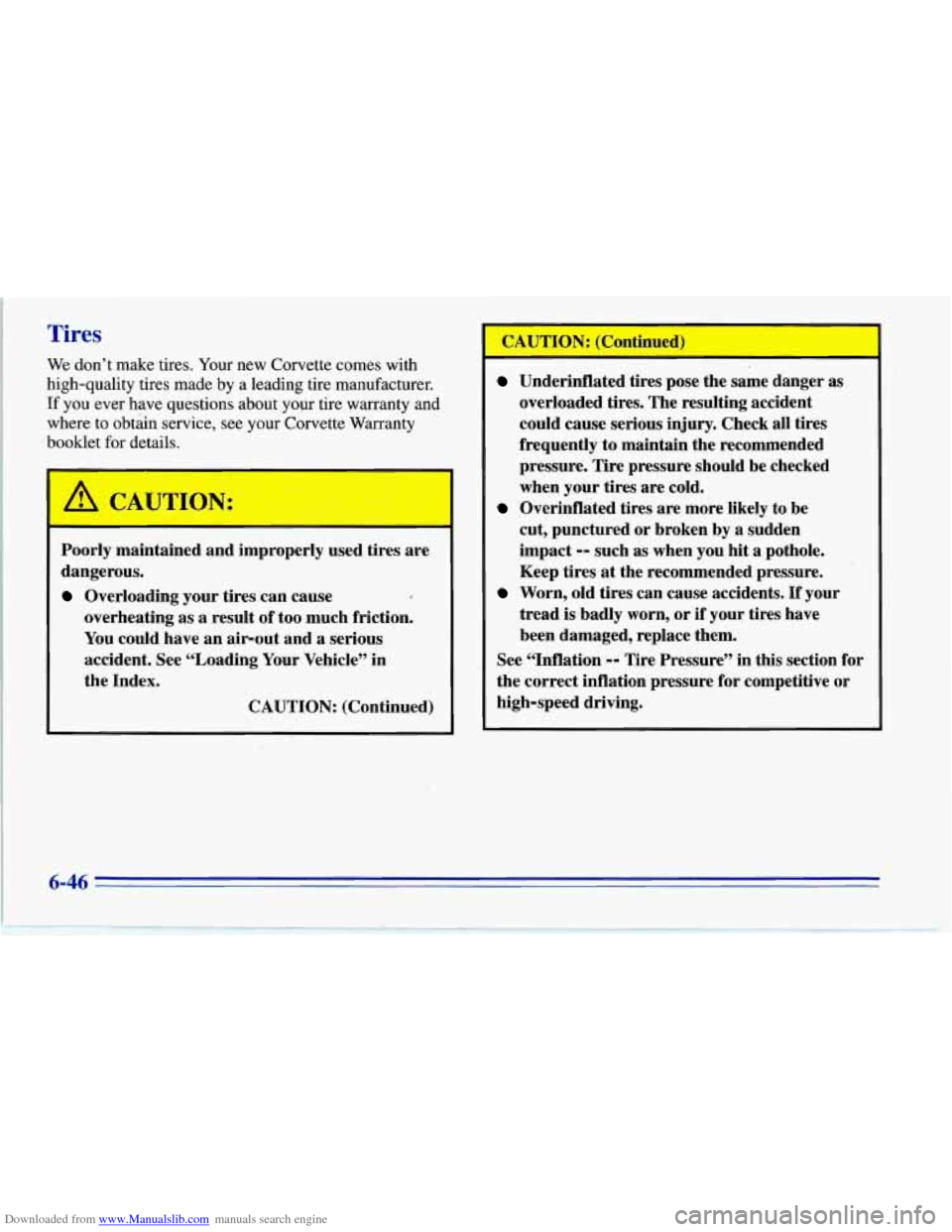
Downloaded from www.Manualslib.com manuals search engine Tires
We don’t make tires. Your new Corvette comes with
high-quality tires made by a leading tire manufacturer.
If you ever have questions about your tire warranty and
where to obtain service, see your Corvette Warranty
booklet for details.
Poorly maintained and improperly used tires are
dangerous.
Overloading your tires can cause
overheating as
a result of too much friction.
You could have an air-out and a serious
accident. See “Loading Your Vehicle” in
the Index.
CAUTION: (Continued) CAUTION: (Co
Underinflated tires
pose the same danger as
overloaded tires. The resulting accident
could cause serious injury. Check all tires
frequently to maintain the recommended
pressure. Tire pressure should be checked
when your tires are cold.
cut, punctured or broken by a sudden
impact
-- such as when you hit a pothole.
Keep tires
at the recommended pressure.
Worn, old tires can cause accidents. If your
tread
is badly worn, or if your tires have
been damaged, replace them.
Overinflated tires are more likely to be
See “1nfla.tion
-- Tire Pressure” in this section for
the correct inflation pressure for competitive or
high-speed driving.
Page 278 of 386
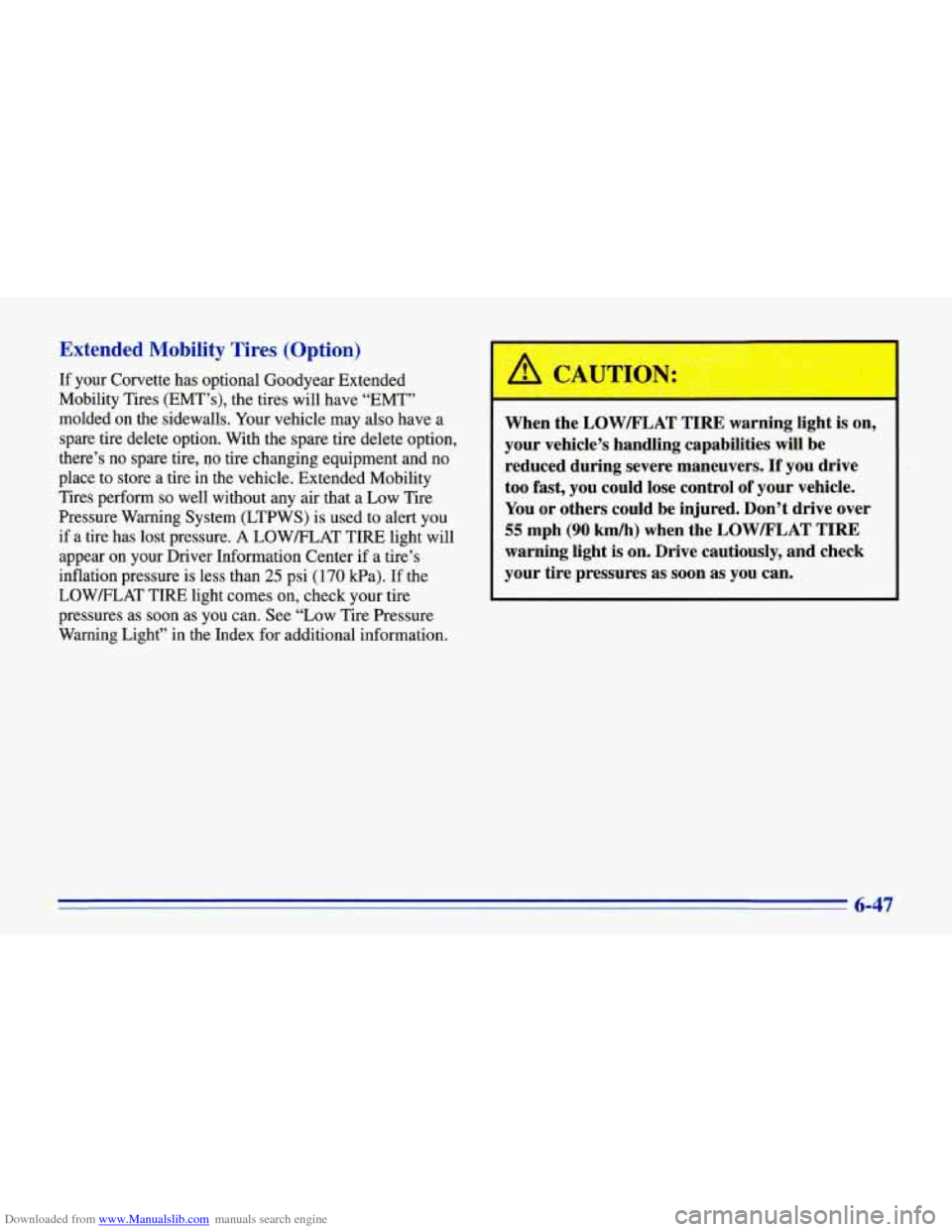
Downloaded from www.Manualslib.com manuals search engine Extended Mobility Tires (Option)
If your Corvette has optional Goodyear Extended
Mobility Tires
(EMT’s), the tires will have “EMT”
molded on the sidewalls. Your vehicle may also have a
spare tire delete option. With the spare tire delete option,
there’s no spare tire,
no tire changing equipment and no
place to store
a tire in the vehicle. Extended Mobility
Tires perform
so well without any air that a Low Tire
Pressure Warning System (LTPWS) is used to alert you
if a tire has lost pressure. A LOWFLAT TIRE light will
appear on your Driver Information Center if a tire’s
inflation pressure is less than
25 psi (170 kPa). If the
LOWFLAT TIRE light comes
on, check your tire
pressures as soon as you can. See
“Low Tire Pressure
Warning Light” in the Index for additional information.
When the LOWELAT TIRE warning light is on,
your vehicle’s handling capabilities will be
reduced during severe maneuvers.
If you drive
too fast, you could lose control of your vehicle.
You or others could be injured. Don’t drive over 1 ,
55 mph (90 kmh) when the LOWLFLAT TIRE
warning light
is on. Drive cautiously, and check
your tire pressures as soon as you can.
I
6-47
Page 279 of 386

Downloaded from www.Manualslib.com manuals search engine If a tire goes flat, you won’t need to stop on the side of
the road to change the tire.
You can just keep on driving.
The shorter the distance you drive and the slower the
speed, the greater the chance that the tire will not have
to be replaced. If you drive on a deflated EMT for
distances of
50 miles (80 km) or less and at speeds of
55 mph (90 km/h) or less, there is a good chance that the
tire can be repaired. The tire can operate effectively with
no air pressure for up to 200 miles (320 km) at speeds
up to
55 mph (90 km/h), but the tire would then have to
be replaced. Also remember: When a tire is filled with
air, it provides a cushion between the road and the
wheel. Because you do not have this cushion when
driving on a deflated tire, try to avoid potholes that
could damage your wheel and require replacement of it.
Some road hazards can damage a
tire beyond repair. This
damage could occur before you’ve driven on the tire in a
deflated condition. Whenever a tire has been damaged, or
if you’ve driven any distance on a deflated
EMT, check
with a Goodyear EMT Service Center to determine
whether the tire can be repaired or should be replaced. To
maintain your vehicle’s extended mobility feature,
all
replacement tires must be Extended Mobility Tires.
See the Goodyear Extended Mobility Tire Owner’s
Manual and Limited Warranty supplied with your
Corvette for additional information.
Inflation -- Tire Pressure
The Tire-Loading Information label, which is on
the rear edge of the driver’s door, shows the correct
inflation pressures for your tires when they’re cold.
“Cold” means your vehicle has been sitting for at least
three hours or driven no more than
1 mile (1.6 km).
For competitive driving or high-speed driving (over
150 mph or 240 km/h), make sure your tires are inflated
to 35 psi
(240 kPa). When you end this type of driving,
reduce the cold inflation pressures (if necessary) to those
listed on the Tire-Loading Information label.
I NOTICE:
Don’t let anyone tell you that underinflation or
overinflation is all right. It’s not. If your tires
don’t have enough air (underinflation), you can get the following:
0 Too much flexing
Too much heat
0 Tire overloading
0 Bad wear
0 Bad handling
Bad fuel economy.
NOTICE: (Continued)
Page 280 of 386
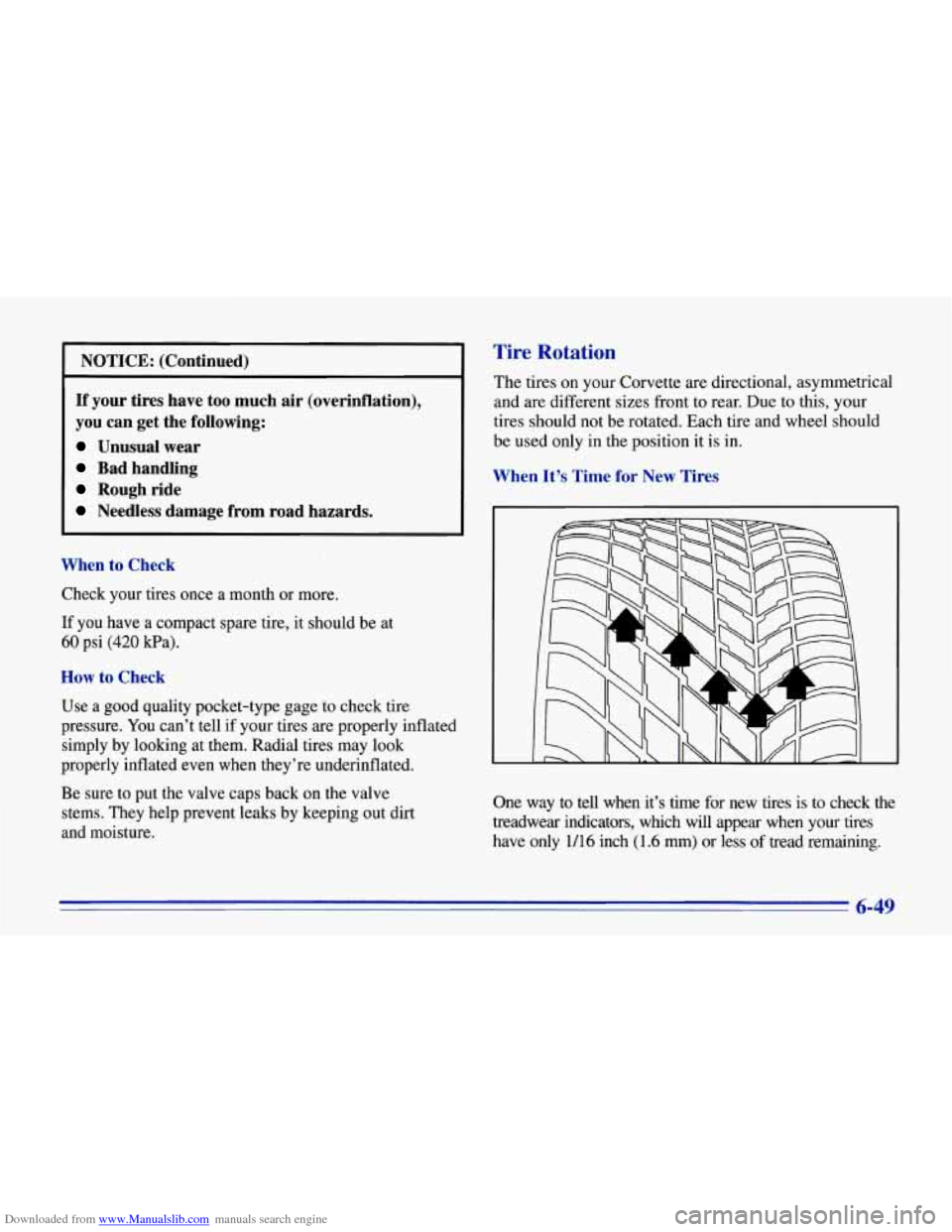
Downloaded from www.Manualslib.com manuals search engine I NOTICE: (Continued) I
If your tires have too much air (overinflation),
you can get the following:
Unusual wear
Bad handling
Rough ride
Needless damage from road hazards.
When to Check
Check your tires once a month or more.
If you have a compact spare tire, it should be at
60 psi (420 Wa).
How to Check
Use a good quality pocket-type gage to check tire
pressure. You can’t tell if your tires are properly inflated
simply by looking at them. Radial tires may look
properly inflated even when they’re underinflated.
Be sure to put the valve caps back on the valve
stems. They help prevent leaks by keeping out dirt
and moisture.
Tire Rotation
The tires on your Corvette are directional, asymmetrical
and are different sizes front to rear. Due to this, your
tires should not be rotated. Each tire and wheel should
be used only in the position it is in.
When It’s Time for New Tires
One way to tell when it’s time for new tires is to check the
treadwear indicators, which will appear when your tires
have
only 1/16 inch (1.6 mm) or less of tread remaining.
6-49